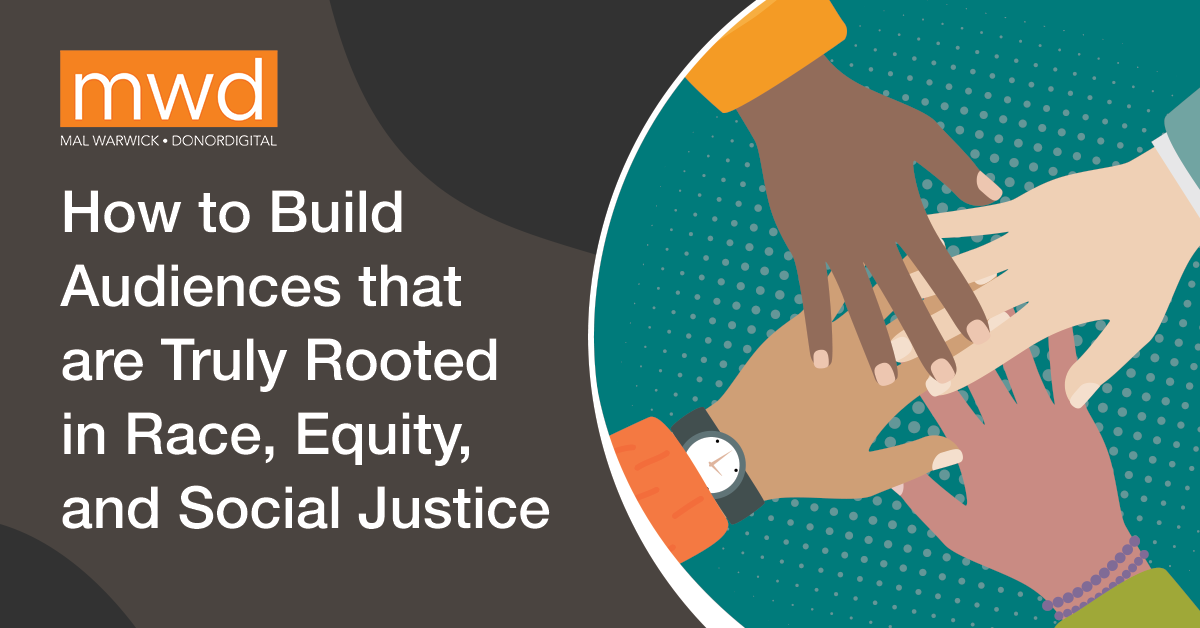
Nonprofit direct response outreach has a diversity problem … and not enough of us are talking about it. Mal Warwick Donordigital (MWD) is an active participant in the effort to diversify nonprofit direct response donor audiences. This includes the critical work to ensure that all donors and prospective donors feel included, valued, and heard in nonprofit fundraising and engagement.
To date, traditional direct response fundraising efforts have solicited a narrow slice of the US population: white, older, more affluent, college-educated people. Yet, we know that many other people in this country give generously to nonprofit causes through other channels and means. The challenge before us now is to expand into those other communities so that our direct response donor audiences more fully reflect the people who reside in this country.
This will require a multi-faceted approach, and — as we’ve seen with other efforts in diversity, equity and inclusion — will be a journey that evolves and changes over time.
MWD has committed to fully engaging in this journey by promoting changes in the larger nonprofit fundraising industry and in the ways that we do our work. We are excited to connect with all of our nonprofit partners to diversify the group of people who choose to support them. In support of that, we’re providing this grounding document that outlines what we think is necessary to truly commit to building and retaining a more diverse donor base.
1. Start Within
Before launching into an effort in expanding diversity, it’s essential to do the internal work of ensuring all people feel welcome, valued, and included. In practice, that’s demonstrating you are committed to diversity across every level of the organization and showing that you’ve taken the time and effort to review your organization’s history — especially as it applies to marginalized groups. When prospective donors view your leadership and Board, does it reflect members of their community? Who will they interface with if they become donors? Who is represented at your donor events? Who’s represented on your collateral materials? Do you have an anti-racism statement or some visible sign of your commitment to racial justice and equity?
2. Build a Fund for Investment
Like testing anything in direct response, finding a new audience will require a significant investment. A substantial financial commitment will allow for ample resources for message creation and testing and audience research over time and through multiple channels. This investment must be maintained for the long-term — not just seen as a test program. We’d suggest earmarking a certain amount in your annual budget for these efforts.
3. Define Potential Audiences
It’s important to go through a process to identify the new audiences for your efforts. This will include a review of current practices that may actually exclude people. For example, lookalike modeling is an effective tool for finding prospective audiences. However, it will only replicate the same demographics that are currently on your file.
4. Develop New Creative and Messaging Platforms
While MWD believes that this should apply to all parts of your fundraising efforts, it’s vitally important to ensure your creative (text and visuals) ethically reflects the people that your work supports and the people you want to engage. It’s also critical that you don’t center current donors (who are most often white) as the solution to the issue your organization is tackling.
5. Don’t Apply the Same Metrics
We can’t apply the same key performance metric benchmarks to these efforts. We’re reaching new audiences with different techniques and tactics. So, while we will always strive for the best results, lowest cost per new donor, and quickest ROI, we can’t assume from the offset that these efforts will mirror that of the traditional direct response donors. Our efforts will be focused on finding ways to resolicit, upgrade, and convert these new donors.
6. Embrace New Ways to Engage Donors
While the focus of our work is direct response engagement, we urge you to review the ways you engage with your constituents. By expanding your ways to engage, you open up opportunities to reach new audiences.
One element could be reviewing and reconsidering the ways you communicate with audiences and how you tell your story — in particular, how you use the stories of your program participants. We strongly encourage that the storytelling you utilize in fundraising and marketing ethically and respectfully honors the people and communities you serve.
Finally, we know this work may seem daunting — and we think it’s healthy to approach it with some uncertainty of results. That said, we also hope that you approach it with energy and optimism! The truth is the work we’re doing now is critical for the success of our fundraising programs in the future. Finding and cultivating new audiences will build a base of donors to replace audiences that we will be losing in the next decades.
MWD is your partner in this work, and we are excited to collaborate together, just let us know how we can help!


Mwosi Swenson, President & CEO, has worked in direct response fundraising for over 25 years. She’s worked with some of the nation’s most respected environmental, advocacy, and political organizations. Mwosi’s work in building long-lasting relationships with individual donors through effective integrated direct marketing has motivated hundreds of thousands of people to give millions of dollars to worthy causes nationally and around the world.
![[ Facebook ]](/img/connect-facebook.png)
![[ Twitter ]](/img/connect-twitter.png)